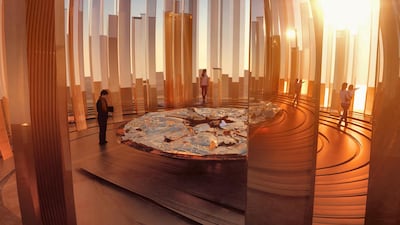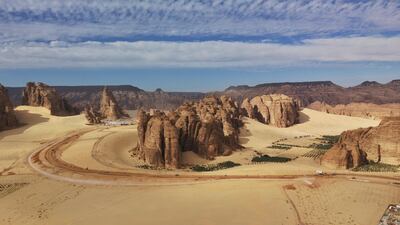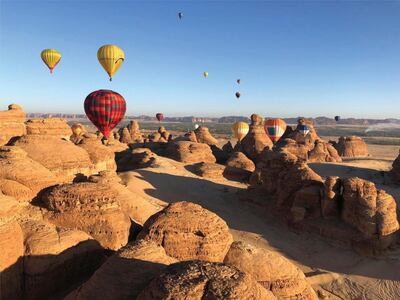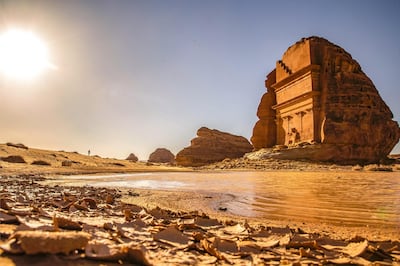On Wednesday, Saudi Arabia's Crown Prince Mohammed bin Salman announced an exciting new master plan set to transform Al Ula into a must-visit destination for travellers across the world.
Encompassing five distinct districts interconnected by a low-carbon tramway, the Journey Through Time project offers culture, art, history, adventure and more in north-west Saudi Arabia.
While the kingdom is not currently accepting international travellers due to the global pandemic, the parts of Al Ula that are already open have been enjoying a surge in popularity, driven by demand from Saudis who cannot travel abroad.
Phillip Jones, chief destination marketing officer of the Royal Commission for Al Ula (RCU), tells The National that "because of the lack of international travel in Saudi Arabia, we've become quite the popular destination for domestic travellers".
"We've seen 24,000 visitors over the past couple of months and are at 100 per cent occupancy in all our existing hotels."
Capitalising on that demand, the destination is set to play host to the first performance at Unesco World Heritage Site Hegra on Thursday, April 8, with Italian opera tenor Andrea Bocelli as the star.
When borders do open to international travellers, the new master plan will ensure Al Ula "becomes a top heritage site that will rival any other in the world", says Jones.
If you're thinking a visit to one of the world's most historical sites might be in your travel future, here's a guide to what you need to know before setting off on Saudi Arabia's Journey Through Time.
What is the Journey Through Time?
Essentially, the Journey Through Time is a route that spans five districts across the Al Ula region. Starting at Al Ula's Old Town in the south, it winds on towards Dadan and up to Jabal Ikmah, before taking in the Nabataean Horizon. The fifth and final point of the journey is Hegra, the southern capital of the Nabataean civilisation and Saudi Arabia's first Unesco World Heritage Site.
The plan follows the framework of Saudi Vision 2030 and was developed under the leadership of the Crown Prince and the guidance of Prince Badr, Saudi Arabia's Minister of Culture and governor of the RCU.
The plan is designed to showcase a place of harmonious co-existence between nature and humans, preserving the cultural legacy of Al Ula and providing development opportunities and sustainable economic growth.
When completed, the project hopes to attract two million visitors every year to the historic region.
How do I get there?
Travellers who want to experience the Journey Through Time can fly directly to Prince Abdul Majeed bin Abdulaziz airport in Al Ula, which has been expanded to receive international flights.
The airport has the capacity to handle 400,000 passengers a year and it's less than a 30-minute drive from the airport to Al Ula Old Town. Travellers can also fly into Prince Mohammad bin Abdulaziz International Airport in Madinah, from where it's about a five-hour drive to Al Ula.
Where can I stay?
Positioning itself as a luxury destination, Al Ula is set to have 5,000 hotel rooms by 2030. Right now, there's a little less to choose from.
The Shaden Resort is open for visitors and offers 121 rooms and villas, all of which have a private terrace or balcony looking out to the surrounding rock formations. Sahary Al ula Resort is also accepting guests. It has 80 secluded tent-style suites, an indoor pool and a garden area.
Several more hotels are set to open as part of the Journey Through Time master plan with properties spread throughout the five districts. "Our focus right now is the Ashar Valley where we have two hotels opening in August," says Jones.
The first of these is the 100-room Habitas AlUla. This modern, offbeat hotel brand prioritises sustainability and will use 3D printing to create 100 standalone capsules. Using light-on-the-planet materials, the hotel will also utilise local produce and resources.
Music sunset sessions, astronomy-driven yoga and spa therapies infused with local jasmine, frankincense and the Taif oud will be on the cards for visitors, as will plenty of adventure offerings, from canyon trekking to learning desert survival skills.
Also opening this year is a 77-key Banyan Tree resort, the first of the Accor brand to open in Saudi Arabia. Jones says the resort, which offers luxury tented villas, will be "five-star-plus with resort style pools, and some spas and some amazing restaurants".
Other hotels scheduled to open include three Aman Resorts, one a luxury tented camp, another a desert ranch-style hotel and the third one of the hotel's group's new 'conscious mindset' Janu hotels.
Other new hotels will be announced over the coming months and, by the end of 2023, there will be a total of 1,000 keys. Right now, accommodation options are all high-end offerings, so visitors should expect price points to match.
"Initially our goal is hyper-luxury and luxury, and then we'll start to spread out a little bit and add more inventory, perhaps four-star or maybe three-star hotels for travellers," says Jones.
How long should I spend there?
The enormous region of Al Ula is about the same size as Belgium and also very sparsely populated, with fewer than 50,000 people living there. This means a one-night stay isn't going to allow visitors to easily take in the whole journey.
"Right now, our average visitor stay is about 2.8 days, but by the time all the development is completed, you'd want to have a minimum of five nights, and ideally would spend seven days in the destination," says Jones.
As development continues, there will also be opportunities for long-term stays and immersive travel opportunities across the districts, as well as day-trip options to neighbouring developments.
When's the best time of year to visit?
The main season at Al Ula currently runs from October to April, with limited activities operating during the summer months, but there are plans to extend this, explains Jones.
"We have a vision to make it a year-round destination and, with the beautiful oasis, there's a lot of opportunity to develop an area for summer visits where it's cooler or shaded."
What can I see and do?
The Wadi of Hospitality will be the central spine of the area. Located in the oasis, which is being carefully regenerated, it will be a series of restaurants, museums and attractions spread throughout the wadi.
This is where visitors will be able to enjoy the beauty of the oasis and take part in local activities. "Visitors will be able to visit farms, drink fresh juices, pick dates; it will all be very interactive and it's going to be a very special place in Saudi Arabia," says Jones.
Visitors can access all five of the Journey Through Time districts via a low-carbon tram that will run across all 46 kilometres. This will be a hop-on, hop-off service and an efficient way to take in the surrounding natural beauty.
Each district offers something different for visitors, here's some of the highlights:
District 1: Al Ula Old Town
The starting point of the Journey Through Time is Al Ula's Old Town and the Cultural Oasis. Uninhabited for more than 40 years, the town was closed completely in 2017 by the RCU, but is now welcoming guests with restored streets, buildings and attractions. Here, travellers will be immersed in arts and culture with the Arts District set to preserve the area's character; the paradigm-shifting Perspectives Galleries is also one of the new highlights. With nearly 900 houses, 400 shops and five town squares, the Old Town is also home to Masjid Al Izam, the restored Friday mosque believed to have been visited by the Prophet Mohammed.
District 2: Dadan
Dadan, the land of the Ancient Kingdoms of north-west Arabia, is the second district in the journey and it's one that is set to enthral through its history.
With soaring red rocks and many heritage sites, Dadan is the place for travellers interested in finding out more about Al Ula's rich past. The archaeological epicentre of the Dadanite and Lihyanite kingdoms that continue to reveal secrets, Dadan District will also be home to new resorts, hotels and the modern Dadan Village.
The Black Basalt Museum will be found here, as will The Kingdoms Institute. This landmark will become one of the cultural centres of Saudi Arabia and a global hub and learning centre for archaeological research about the civilisations that have inhabited Al Ula. The design of the cluster of buildings making up The Kingdoms Institute is inspired by the Dadan civilisation, and they will appear as if carved in the mountains opposite the archaeological site of Dadan.
District 3: Jabal Ikmah
Set among the ageless rocks of Al Ula, Jabal Ikmah is home to an open-air library of petroglyphs, making it a natural and monumental testimony of times gone by.
Set to attract archaeology-loving travellers keen to discover more about the tracks and writings of the civilisations of Al Ula, there are also new cultural anchors. The Jabal Ikmah Interpretive Centre will join the historic Hijaz Railway Station on the edge of the oasis among the date palms and, on the opposite side of the valley, the Incense Museum and Gardens are set to include public gardens, galleries and a wellness centre.
District 4: Nabataean Horizon
Sweeping across the Al Ula landscape, the Nabataean Horizon is akin to Jordan's Petra.
Travellers will be able to visit the carved village, a new cultural site that mirrors Nabataean architecture with buildings and sites carved into the rock faces. A Nabataean amphitheatre will be the place to go for live open-air performances.
Arabian Horse Heritage will be the hub for equestrianism in the valley, with travellers invited to share immersive experiences based on the ancient Nabataean lifestyle. It's also set to be home to a wide variety of accommodation options, including tented resorts, canyon resorts and a recreational vehicle park.
District 5: Hegra Historical City
The jewel in the crown of the Journey Through Time is the Hegra historical city. The southern capital of the Nabataean civilisation, and Saudi Arabia's first Unesco World Heritage Site, is where travellers can explore the colossal monuments belonging to a vanished civilisation.
Home to more than 110 tombs and numerous archaeological sites, travellers can see the Tomb of Lihyan Son of Kuza and Qasr Al Bint and explore the Hegra Fort and restored Hijaz Railway Station.
Like in Petra, many of the Hegra tombs feature awe-inspiring carved facades but, unlike Jordan, in Saudi Arabia many of the facades also carry Nabataean inscriptions detailing the dead and offering a glimpse into the lives of the people who used to call these ancient lands home.




























































